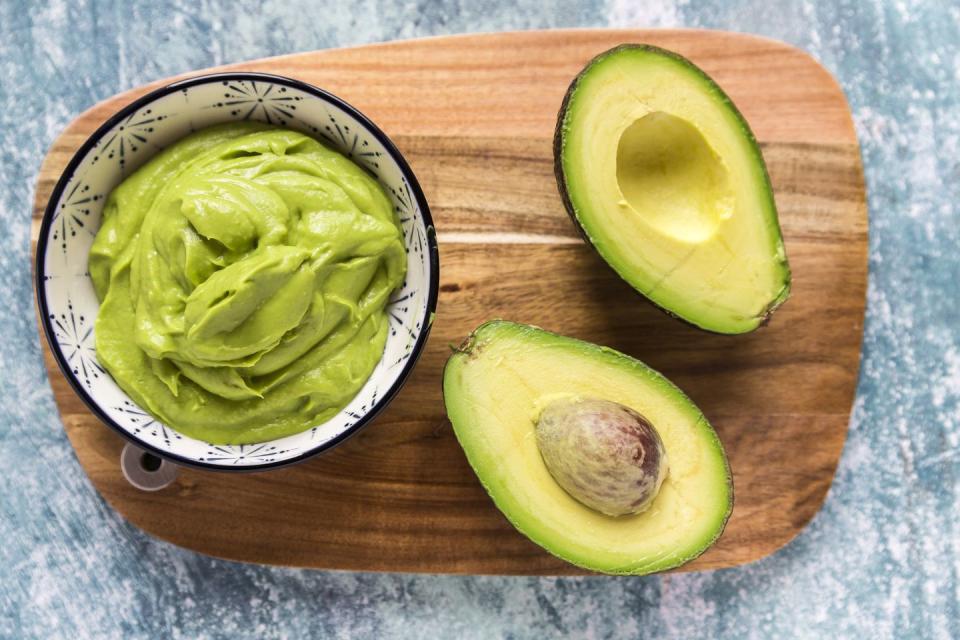FYI: You Shouldn't Be Eating the Pit of an Avocado

With their smooth, creamy texture, and huge degree of versatility, avocados have become an increasingly trendy fruit (yes, fruit!) — and for good reason. They're well known for their healthy fats, but avocados also have a ton of fiber. In fact, avocados are packed with often-overlooked nutrients. Read on for more reasons why you should add this Instagram-friendly superfood to your plate more often.
Nutrition Stats
Serving Size: 1/2 avocado
114 calories
6g carbohydrates
1g protein
10.5g total fat (16% DV)
1g saturated fat
5g fiber
0g sugar
345mg potassium (10% DV)
20mg magnesium (5% DV)
6mg vitamin C (10% DV)
0.2mg vitamin B6 (10% DV)
Health Benefits of Avocados
All of the unsaturated fats, fiber, and phytochemicals (biologically active components of plants) in avocados work a lot of magic. Eating them can:
Lower LDL cholesterol: Avocados themselves contain no cholesterol and the unsaturated fats they do have may help get "bad" cholesterol in check. According to the Hass Avocado Board, avocados are also the richest known fruit source of phytosterols, important cholesterol-lowering compounds.
Boost your heart health: The fats and fiber may help lower your risk of cardiovascular disease.
Promote eye, skin, and bone health: Phytochemicals like carotenoids and phytosterols reduce oxidative and inflammatory stress.
Promote nutrient absorption: The unsaturated fat in avocados helps increase the absorption of fat-soluble vitamins A, D, K, and E, while the vitamin C helps your body absorb iron and Vitamin D.
Improve digestion: Fiber in general helps keep you fuller longer, but avocados are also a good source of a fruit fiber called pectin, which supports a healthy gut.
Manage weight and glucose: One small study (supported by the Hass Avocado Board) found that when people replaced carbohydrates with avocado, they felt more satisfied after eating and had better glucose control.
Now that you've got the deets, here are the top questions nutritionists get about avocados, answered:
Are avocados fattening?
Avocados are rich in mono- and poly-unsaturated fats — the healthy kinds that actually reduce your risk of heart disease and stroke. Clinical trials have consistently found that eating avocado can lower your LDL cholesterol and improve lipid and lipoprotein profiles. Just keep in mind that avocados aren’t calorie-free so if you’re trying to lose weight, you might not want to add guacamole to everything.

Will avocados make you gain weight?
Studies have shown that moderate consumption of avocados and other healthy fats can actually promote weight loss through its effect on satiety. The water content and dietary fiber help you feel full, meaning you're less likely to overeat throughout the rest of the day. Try integrating them into a DASH (Dietary Approaches to Stop Hypertension) or Mediterranean-style eating plan if you're looking to lose or maintain weight.
How much can I eat and what should I eat them with?
As with most foods, it's important not to go overboard. We recommend keeping serving sizes to 1/4 to 1/2 an avocado per meal or snack, and having no more than one whole avocado per day. But think beyond avocado toast — there are unique ways to eat them, too! Use avocados to add variety to your meal routine with one of these recipes:
Put avocado in your salad to make it more filling
Substitute it for mayo in tuna or egg salad sandwiches
Make "creamy" pasta sauces (such as avocado pesto)
Indulge in avocado chocolate mousse or spicy chocolate muffins
Freeze slices and then blend into an avocado smoothie
Spice up your backyard barbecue by grilling avocados
Mix up an avocado piña colada without adding sugar
Serve avocado dip as an alternative to guacamole
Should you eat the pit?
You may have heard that you should eat the seed of an avocado because it contains beneficial antioxidants and fiber. However, the California Avocado Commission does not recommend eating the pit. While preliminary studies have shown that the avocado seed does contain various phytochemicals, studies have only looked at their functional properties in rats, in vitro, or topically. No studies have examined the effects (or safety) of eating the entire pit for humans.
What's the best way to pit, peel, slice and store avocados?
Watch the video below for detailed real-life instructions — or follow these steps:
With a paring knife, cut avocado from top to bottom and around the pit, then twist halves to separate.
Hold the half with the pit in it tightly with a kitchen towel and strike the pit with the blade of a chef's knife.
Twist the blade and pull it away to release the pit from the fruit.
Use the thumb and forefinger that are holding the knife to carefully push the pit off the knife.
To create slices or chunks, use a paring knife to cut through the avocado, but not through the peel, then use a spoon to scoop out the slices.
If you're only using half right now, prevent browning on the other half by brushing it with lime juice, then pressing plastic wrap onto the surface
— additional reporting by Jaclyn London, MS, RD, CDN
You Might Also Like


